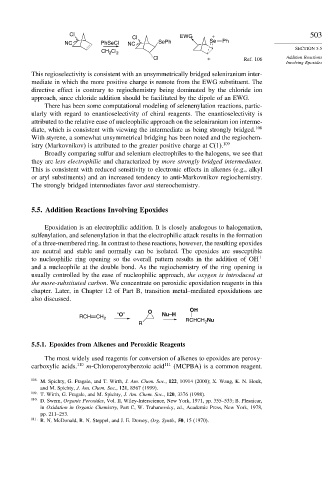Page 522 - Advanced Organic Chemistry Part A - Structure and Mechanisms, 5th ed (2007) - Carey _ Sundberg
P. 522
Cl 503
Cl EWG +
NC PhSeCl NC SePh Se Ph
SECTION 5.5
CH Cl 2
2
Cl + Ref. 106 Addition Reactions
Involving Epoxides
This regioselectivity is consistent with an unsymmetrically bridged seleniranium inter-
mediate in which the more positive charge is remote from the EWG substituent. The
directive effect is contrary to regiochemistry being dominated by the chloride ion
approach, since chloride addition should be facilitated by the dipole of an EWG.
There has been some computational modeling of selenenylation reactions, partic-
ularly with regard to enantioselectivity of chiral reagents. The enantioselectivity is
attributed to the relative ease of nucleophilic approach on the seleniranium ion interme-
diate, which is consistent with viewing the intermediate as being strongly bridged. 108
With styrene, a somewhat unsymmetrical bridging has been noted and the regiochem-
istry (Markovnikov) is attributed to the greater positive charge at C(1). 109
Broadly comparing sulfur and selenium electrophiles to the halogens, we see that
they are less electrophilic and characterized by more strongly bridged intermediates.
This is consistent with reduced sensitivity to electronic effects in alkenes (e.g., alkyl
or aryl substituents) and an increased tendency to anti-Markovnikov regiochemistry.
The strongly bridged intermediates favor anti stereochemistry.
5.5. Addition Reactions Involving Epoxides
Epoxidation is an electrophilic addition. It is closely analogous to halogenation,
sulfenylation, and selenenylation in that the electrophilic attack results in the formation
of a three-membered ring. In contrast to these reactions, however, the resulting epoxides
are neutral and stable and normally can be isolated. The epoxides are susceptible
to nucleophilic ring opening so the overall pattern results in the addition of OH +
and a nucleophile at the double bond. As the regiochemistry of the ring opening is
usually controlled by the ease of nucleophilic approach, the oxygen is introduced at
the more-substituted carbon. We concentrate on peroxidic epoxidation reagents in this
chapter. Later, in Chapter 12 of Part B, transition metal–mediated epoxidations are
also discussed.
OH
O
“O” Nu–H
RCH CH 2
2
R RCHCH Nu
5.5.1. Epoxides from Alkenes and Peroxidic Reagents
The most widely used reagents for conversion of alkenes to epoxides are peroxy-
carboxylic acids. 110 m-Chloroperoxybenzoic acid 111 (MCPBA) is a common reagent.
108 M. Spichty, G. Fragale, and T. Wirth, J. Am. Chem. Soc., 122, 10914 (2000); X. Wang, K. N. Houk,
and M. Spichty, J. Am. Chem. Soc., 121, 8567 (1999).
109
T. Wirth, G. Fragale, and M. Spichty, J. Am. Chem. Soc., 120, 3376 (1998).
110 D. Swern, Organic Peroxides, Vol. II, Wiley-Interscience, New York, 1971, pp. 355–533; B. Plesnicar,
in Oxidation in Organic Chemistry, Part C, W. Trahanovsky, ed., Academic Press, New York, 1978,
pp. 211–253.
111
R. N. McDonald, R. N. Steppel, and J. E. Dorsey, Org. Synth., 50, 15 (1970).

